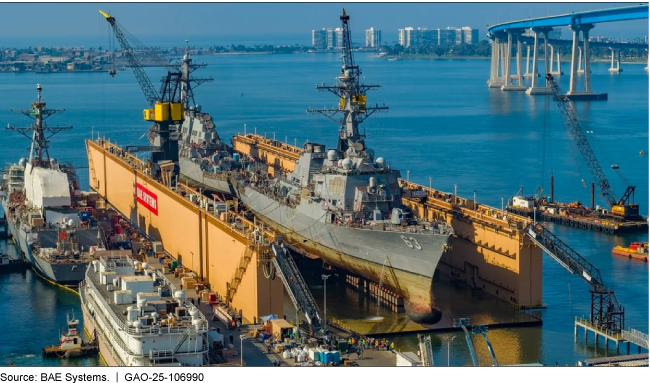Navy Surface Ships: Maintenance Funds and Actions Needed to Address Ongoing Challenges
Fast Facts
The Navy has struggled to effectively maintain its combat surface ships. Our prior reports identified shortages of spare parts and trained personnel, postponed maintenance, and more.
This Q&A review examines the Navy's budget process for sustaining its non-nuclear-powered combat ships, how much it requested and spent on maintenance, and the status of these maintenance challenges.
The Navy:
Received about $1 billion more than the $24.9 billion it requested for maintenance during FY 2020-2023
Committed to spending 99.7% of that funding by the end of FY 2023
Continues to face the challenges we previously identified

Highlights
What GAO Found
The Department of Defense (DOD) spends tens of billions of dollars of operations and maintenance (O&M) and other appropriated amounts annually to operate and maintain its weapon systems, including combat surface ships.
As of 2024, the Navy operates 149 of these ships—such as destroyers, cruisers and amphibious assault ships. GAO found that:
- The Navy requested almost $24.9 billion to maintain combat surface ships during fiscal years 2020 through 2023. The Navy reported that almost $25.9 billion was appropriated for maintenance activities during those same years – $1 billion more than requested.
- As of the end of fiscal year 2023, the Navy reported obligating 99.7 percent of the $25.9 billion, or about 25.8 billion, for expenditure to sustain combat surface ships during fiscal years 2020 through 2023.
- The Navy has a detailed process to manage surface ship sustainment that involves developing a budget, submitting the budget request, executing (obligating and expending) the funds, and reporting on results.
- The Navy still faces persistent challenges sustaining combat surface ships, including limited spare parts, a lack of sufficient and qualified maintenance personnel, and a continual need to defer maintenance.
Why GAO Did This Study
The U.S. Navy operates 149 non-nuclear combat surface ships—cruisers, destroyers, the littoral combat ships, and amphibious assault ships. These ships account for roughly two-thirds of the Navy's battle force and require timely maintenance to ensure they are available when needed.
House Report 118-125, accompanying a bill for the National Defense Authorization Act for Fiscal Year 2024, includes a provision for GAO to review the sustainment budget for surface ships (H. R. No 118-125, (2023)). This report provides information on how the Navy develops its funding requirements for sustaining combat surface ships; amounts requested and used for such ships' maintenance during fiscal years 2020 through 2023; and long-standing maintenance challenges the Navy faces. We reviewed Navy documentation, interviewed cognizant Navy officials, and collected and assessed Navy appropriations data as part of this study. In a selection of reports published from 2020 through 2024 on Navy ship sustainment, GAO has made a total of 46 recommendations that, as of September 2024, have not been implemented. For example, GAO recommended that the Navy: (1)set material availability requirements that fully capture all factors that could preclude a ship from being ready when needed; (2)require documentation of the factors it considers when determining whether enlisted crewing target levels should be adjusted; and (3)annually report on the assessments of the operational, technical, and economic risks associated with deferred maintenance on surface ships. The Navy is currently making some progress towards implementing 12 of the 46 recommendations.
Recommendations
In a selection of reports published from 2020 through 2024 on Navy ship sustainment, GAO has made a total of 46 recommendations that, as of September 2024, have not been implemented. For example, GAO recommended that the Navy:
- set material availability requirements that fully capture all factors that could preclude a ship from being ready when needed;
- require documentation of the factors it considers when determining whether enlisted crewing target levels should be adjusted; and
- annually report on the assessments of the operational, technical, and economic risks associated with deferred maintenance on surface ships.
The Navy is currently making some progress towards implementing 12 of the 46 recommendations.
